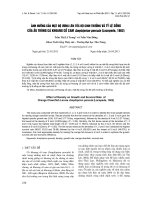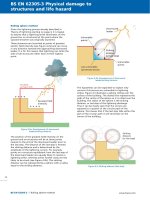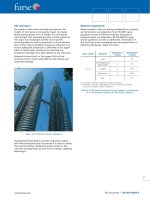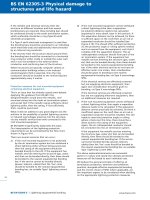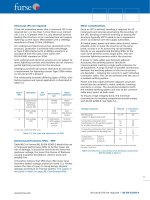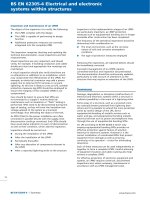Bsi bs en 00847 2 2013
Bạn đang xem bản rút gọn của tài liệu. Xem và tải ngay bản đầy đủ của tài liệu tại đây (1002.43 KB, 24 trang )
BS EN 847-2:2013
BSI Standards Publication
Tools for woodworking —
Safety requirements
Part 2: Requirements for the shank of shank
mounted milling
BS EN 847-2:2013
BRITISH STANDARD
National foreword
This British Standard is the UK implementation of EN 847-2:2013. It
supersedes BS EN 847-2:2001 which is withdrawn.
The UK participation in its preparation was entrusted to Technical
Committee MTE/23, Woodworking machines.
A list of organizations represented on this committee can be
obtained on request to its secretary.
This publication does not purport to include all the necessary
provisions of a contract. Users are responsible for its correct
application.
© The British Standards Institution 2013. Published by BSI Standards
Limited 2013
ISBN 978 0 580 75761 7
ICS 79.120.10
Compliance with a British Standard cannot confer immunity from
legal obligations.
This British Standard was published under the authority of the
Standards Policy and Strategy Committee on 31 October 2013.
Amendments issued since publication
Date
Text affected
BS EN 847-2:2013
EN 847-2
EUROPEAN STANDARD
NORME EUROPÉENNE
EUROPÄISCHE NORM
October 2013
ICS 79.120.10
Supersedes EN 847-2:2001
English Version
Tools for woodworking - Safety requirements - Part 2:
Requirements for the shank of shank mounted milling
Outils pour le travail du bois - Prescriptions de sécurité Partie 2: Prescriptions pour les queues des fraise à queue
Maschinen-Werkzeuge für Holzbearbeitung Sicherheitstechnische Anforderungen - Teil 2:
Anforderungen für den Schaft von Fräswerkzeugen
This European Standard was approved by CEN on 10 August 2013.
CEN members are bound to comply with the CEN/CENELEC Internal Regulations which stipulate the conditions for giving this European
Standard the status of a national standard without any alteration. Up-to-date lists and bibliographical references concerning such national
standards may be obtained on application to the CEN-CENELEC Management Centre or to any CEN member.
This European Standard exists in three official versions (English, French, German). A version in any other language made by translation
under the responsibility of a CEN member into its own language and notified to the CEN-CENELEC Management Centre has the same
status as the official versions.
CEN members are the national standards bodies of Austria, Belgium, Bulgaria, Croatia, Cyprus, Czech Republic, Denmark, Estonia,
Finland, Former Yugoslav Republic of Macedonia, France, Germany, Greece, Hungary, Iceland, Ireland, Italy, Latvia, Lithuania,
Luxembourg, Malta, Netherlands, Norway, Poland, Portugal, Romania, Slovakia, Slovenia, Spain, Sweden, Switzerland, Turkey and United
Kingdom.
EUROPEAN COMMITTEE FOR STANDARDIZATION
COMITÉ EUROPÉEN DE NORMALISATION
EUROPÄISCHES KOMITEE FÜR NORMUNG
CEN-CENELEC Management Centre: Avenue Marnix 17, B-1000 Brussels
© 2013 CEN
All rights of exploitation in any form and by any means reserved
worldwide for CEN national Members.
Ref. No. EN 847-2:2013: E
BS EN 847-2:2013
EN 847-2:2013 (E)
Contents
Page
Foreword ..............................................................................................................................................................3
Introduction .........................................................................................................................................................4
1
Scope ......................................................................................................................................................5
2
Normative references ............................................................................................................................5
3
Terms and definitions ...........................................................................................................................5
4
List of significant hazards ....................................................................................................................6
5
5.1
5.2
5.3
Safety requirements ..............................................................................................................................6
General requirements for cylindrical shank .......................................................................................6
Stability of the shank of mounted tools ..............................................................................................6
Stability of HSK mounted tools ......................................................................................................... 12
6
Tool marking ....................................................................................................................................... 14
Annex A (informative) Examples of calculation ............................................................................................ 16
A.1
Example of a calculation of nshank...................................................................................................... 16
A.2
Example of a calculation of nHSK ....................................................................................................... 17
Annex B (informative) Method of measuring the eccentricity at clamping devices .................................. 18
Bibliography ..................................................................................................................................................... 19
2
BS EN 847-2:2013
EN 847-2:2013 (E)
Foreword
This document (EN 847-2:2013) has been prepared by Technical Committee CEN/TC 142 “Woodworking
machines - Safety”, the secretariat of which is held by UNI.
This European Standard shall be given the status of a national standard, either by publication of an identical
text or by endorsement, at the latest by April 2014, and conflicting national standards shall be withdrawn at the
latest by April 2014.
Attention is drawn to the possibility that some of the elements of this document may be the subject of patent
rights. CEN [and/or CENELEC] shall not be held responsible for identifying any or all such patent rights.
This document supersedes EN 847-2:2001.
The following table contains a list of modifications from the previous edition.
EN 847-2:2001
EN 847-2:2013
Reason
1 Scope
1 Scope:
Precision of the indent
New paragraph: applies also for
shank tools with a cutting diameter
of less than 16 mm
ed/te
3 Quantities and units
3 Terms and definitions
ed
5 Tool marking
5 Safety requirements:
5.1 General requirements for
cylindrical shank
5.2 Stability of the shank of the
shank mounted tools
5.3 Stability of HSK mounted tools
te (missing requirements)
6 Safety requirements
6 Tool marking
Changed symbol
shank length
te
for
the
free
Annex A: Method of measuring
the eccentricity at clamping
devices
Annex A: Examples of calculation
ed
Annex B: Example of calculation
Annex B: Method of measuring the
eccentricity at clamping devices
New: Bibliography
ed
ed
According to the CEN-CENELEC Internal Regulations, the national standards organisations of the following
countries are bound to implement this European Standard: Austria, Belgium, Bulgaria, Croatia, Cyprus, Czech
Republic, Denmark, Estonia, Finland, Former Yugoslav Republic of Macedonia, France, Germany, Greece,
Hungary, Iceland, Ireland, Italy, Latvia, Lithuania, Luxembourg, Malta, Netherlands, Norway, Poland, Portugal,
Romania, Slovakia, Slovenia, Spain, Sweden, Switzerland, Turkey and the United Kingdom.
3
BS EN 847-2:2013
EN 847-2:2013 (E)
Introduction
The content of this European Standard is aimed at eliminating hazards which can lead to overloading of the
shank of shank mounted milling tools for woodworking by excessive rotational speeds.
4
BS EN 847-2:2013
EN 847-2:2013 (E)
1
Scope
This European Standard specifies the determination of the maximum speed for given eccentricity at clamping
devices for the shank strength of milling tools with cylindrical and taper shank. It also specifies the marking of
the tool. Bore mounted tools which are mounted on an arbour should be considered as a shank mounted tool.
This European Standard complements EN 847-1 and applies also for shank tools with a cutting diameter of
less than 16 mm.
2
Normative references
The following documents, in whole or in part, are normatively referenced in this document and are
indispensable for its application. For dated references, only the edition cited applies. For undated references,
the latest edition of the referenced document (including any amendments) applies.
EN 847-1:2013, Tools for woodworking — Safety requirements — Part 1: Milling tools, circular saw blades
EN ISO 12100:2010, Safety of machinery — General principles for design — Risk assessment and risk
reduction (ISO 12100:2010)
ISO 1940-1, Mechanical vibration — Balance quality requirements for rotors in a constant (rigid) state —
Part 1: Specification and verification of balance tolerances
3
Terms and definitions
For the purposes of this document, the terms and definitions given in EN 847-1:2013 and the following apply.
3.1
7/24 shank
SK
type of toolholder with a 7/24 cone ratio taper that contacts the spindle on two surfaces
Note 1 to entry:
Toolholder with a 7/24 cone ratio taper; see Bibliography.
3.2
hollow taper shank
HSK
type of toolholder with a short hollow taper with a high positioning accuracy and high grade of rigidity that
contacts the spindle on two surfaces
Note 1 to entry:
Toolholder with 1:1,09 cone ratio hollow taper shank; see Bibliography.
3.3
arbour
device to mount in or on the spindle of a machine tool, and which is designed to carry and drive a bore type
cutting tool
5
BS EN 847-2:2013
EN 847-2:2013 (E)
4
List of significant hazards
Table 1 shows the list of significant hazards.
Table 1 — List of significant hazards
Hazard according to
EN ISO 12100:2010
Condition or causes of hazard
related to the tool
Mechanical hazards due to:
Corresponding clause of
EN 847-2
Breaking of the tool
5
Vibration
Dynamic unbalance of tool
5
Variations in the rotational speed of
tools
Breaking of the tool
5
Inadequacy of mechanical strength
5
Safety requirements
5.1
General requirements for cylindrical shank
The minimum value for the clamping length le min shall be as given in Table 2.
Table 2 — Minimum clamping length le min
d2 ≤ 10 mm
10 mm < d2 < 25 mm
d2 ≥ 25 mm
le min = 20 mm
le min = 2 ⋅ d2 (mm)
le min = 1,8 ⋅ d2 (mm)
The tolerance of the shank diameter d2 shall be h6 for d2 ≥ 12 mm and h8 for d2 < 12 mm. The method of
measuring the eccentricity em at clamping devices, as given in Annex B, shall be used.
5.2
Stability of the shank of mounted tools
Every shank of a mounted milling tool shall be calculated with the quantities and units as shown in Figure 1a)
(with d = d2).
If the shank mounted milling tool is clamped in a taper holder, the cone strength shall be calculated with the
quantities and units as shown in Figure 1b) (with d = d3 ).
If tools are mounted on a taper shank, the shank strength of the clamping diameter shall be calculated with
the quantities and units as shown in Figure 1c) with
le = lg
l0 = 0
d4 = 1,4 · darbour
(darbour ≤ 50mm)
d4 = 20 + darbour
(darbour > 50mm)
NOTE 1
6
Clamping systems:
with axial clamping force [Fa] d = d4;
without axial clamping force [Fa] d = darbour.
BS EN 847-2:2013
EN 847-2:2013 (E)
a)
b)
Figure 1 — Quantities for calculation of nshank (1 of 2)
7
BS EN 847-2:2013
EN 847-2:2013 (E)
c)
Key
a axis of rotation
Figure 1 — Quantities for calculation of nshank (2 of 2)
For balance quality, see EN 847-1:2013, Table 5.
For calculation of n with a given esp the following formula applies:
− G + G2 +
nshank =
8
30
f
S
⋅π
⋅
W ⋅σ w
*
m ⋅ ls
esp +
⋅ esp +
2
W ⋅ σ w ⋅ l s
W ⋅σ w ⋅ ls
3⋅ E ⋅ I
3⋅ E ⋅ I
2
⋅
10
6
(1)
BS EN 847-2:2013
EN 847-2:2013 (E)
For calculation of esp with a given n the following formula applies:
2
2
W ⋅σ w
30 ⋅ G W ⋅ σ w ⋅ l s
6
⋅
⋅
−
⋅
10
π
3⋅ E ⋅ I
f ⋅ π m* ⋅ l s ⋅ n
S
1
esp = ⋅
n
30
30 ⋅ G
π ⋅ nshank
e per =
(2)
(3)
The mass mcut of the tool components related to the centre of gravity S in the area of l0 + l1, is given in
Figure 1.
m* = f ⋅ mcut
(4)
f = 0,04 + 0,17 ⋅ ln (mcut)
(5)
This is an empiric formula of which the result is only valid between 0,6 and 0,9. If the result is less than 0,6
use 0,6, and if the result is greater than 0,9 use 0,9. The form factor takes into account the deviation of the
actual form (e.g. gullet; flattening) from the solid body form of the tool without shank.
NOTE 2
The expression "In (mcut)" is the natural logarithm of mass of the tool without shank.
I =π⋅
d4
(6)
64
l0 = lg − le
(7)
If known the real mass can be used in place of the reduced mass.
W =π⋅
EXAMPLE
d3
32
(8)
Figure 2 and Formula (9) give an example for the calculation of the distance ls.
9
BS EN 847-2:2013
EN 847-2:2013 (E)
Figure 2 — Distances of the gravity centres of the tool components
lS =
10
m1 ⋅ lS,1 + m2 ⋅ lS,2 + m3 ⋅ lS,3 + m4 ⋅ lS,4
m1 + m2 + m3 + m4
(9)
BS EN 847-2:2013
EN 847-2:2013 (E)
Table 3 — Stability of the shank of the shank mounted tools — Quantities and units
Quantity
d
Description
diameter
Unit
mm
a) shank diameter d2
b) cone diameter d3
c) with axial force d4: calculated; without axial force: darbour
d1
tool diameter
mm
d2
shank diameter, see Figure 1a)
mm
d3
cone diameter, see Figure 1b)
mm
d4
calculated hub diameter, see Figure 1c)
mm
shank diameter of the arbour, see Figure 1c)
mm
darbour
E
eper
esp
permissible gravity centre displacement
eccentricity at clamping device
a
mm
form factor
fs
safety factor (fS = 4)
./.
Fa
axial clamping force, see Figure 1c)
N
G
product of the permissible eccentricity and the angular velocity according to ISO 1940-1
I
second moment of area
mm
l1
height of tool components
mm
l0
free shank length
mm
ls
distance of gravity centre measured from the end of the clamping device
mm
le
clamping length
mm
lg
total length of shank
mm
mcut
mass of the tool components related to the centre of gravity S in the area of l0 + l1,
see Figure 1a) to Figure 1c)
m*
reduced mass of the tool
nshank
2
mm
f
n
a
N mm−
modulus of elasticity
mm s−
1
4
g
operational speed
min−
1
maximum permissible rotational speed with regard to shank strength
min−
1
S
centre of gravity
W
section modulus
σw
fatigue strength under reversed bending stresses of shank material
N mm−
2
ρ
density of shank material
g mm−
3
mm
3
It is intended to determine mean values for stationary routing machines and hand held routing machines by concluding
serial tests in order to provide the designer with safety indications and to reduce hazards.
For general use nshank shall be calculated for esp = 0,1 mm and for tools used on NC- and CNC-machines nshank
shall be calculated for esp = 0,06. In other cases the value of esp shall be taken according to the formula.
11
BS EN 847-2:2013
EN 847-2:2013 (E)
NOTE 3
The safety requirements for the shank strength are fulfilled when, using the given tool sizes and material
characteristics with defined free shank length l0, gravity centre displacement eper and eccentricity at clamping device esp,
the maximum permissible rotational speed for the shank nshank is not exceeded during operation. The cutting force is not
significant in comparison with the centrifugal force. Therefore, the cutting force has not been taken into account.
For the operation of complex shank mounted milling tools it has to be considered that the maximum
permissible operational speed may not exceed the lower value of the two maximum speed values for the
shank strength (nshank) as well as the strength to overspeed load (nmax) in accordance with EN 847-1:2013,
5.1.4.1.
5.3
Stability of HSK mounted tools
Figure 3 — Quantities for calculation of nHSK
If more than one tool is mounted on an HSK-arbour the tool with the highest value FC x lC should be used for
the calculation of nHSK.
For calculation of nHSK the following formula applies:
nHSK =
30
fS ⋅π
⋅ 10 3 ⋅
e = eHSK + eM + eT
eHSK =
12
2 ⋅ (l s ⋅ t p )
d HSK
+ tr
FHSK ⋅
d HSK
− Fc ⋅ l c
2
m ⋅ e ⋅ ls
(10)
(11)
(12)
BS EN 847-2:2013
EN 847-2:2013 (E)
eM =
eT =
Db max − d s min
2
G
ω
=
G T ⋅ 30
π ⋅ nmax
(13)
(14)
If Fc is unknown, Fc can be calculated according to EN 847-1:
Fc = Fm ⋅ b 1
Fm = 50 N/mm (for tools with a cutting radius r1 ≤ 20 mm)
30 ⋅ PMot
Fm =
⋅ 10 6 (for tools with a cutting radius r1 > 20 mm)
r1 ⋅ b1 ⋅ nmax ⋅ π
(15)
Alternative Fc can be calculated as transmissible force according to the spindle power:
Fc =
Pc
30 ⋅ PMot
≈
⋅ 10 6
vc π × r1 ⋅ nmax
(16)
13
BS EN 847-2:2013
EN 847-2:2013 (E)
Table 4 — Stability of HSK mounted tools — Quantity and units
Quantity
Unit
C
resulting working point of the cutting forces reduced to the tool axis
./.
b1
cutting width according to EN 847-1
mm
maximum bore diameter (e.g. tool bore)
mm
dHSK
nominal diameter of the HSK (e.g. HSK-F63: dHSK = 63 mm)
mm
ds min
minimum shaft diameter (e.g. arbour)
mm
gravity centre displacement of the complete tool (worst case)
mm
eccentricity of the tool caused by the tolerances of the HSK
mm
eM
eccentricity of the tool caused by mounting tolerances between bore and arbour
mm
eT
gravity centre displacement of the mounted tool caused by unbalancing
mm
Fc
cutting force
N
Fm
specific cutting force
N/mm
clamping force of the HSK (guideline values are given in DIN 69893)
N
fS
safety factor (fS = 4)
./.
G
product of the permissible eccentricity and the angular velocity according to ISO 1940-1
mm s
lc
axial distance of the working point of the cutting force from the face stop of the HSK
mm
ls
distance of the gravity centre from the face stop of the HSK
mm
m
total mass of the complete tool (individual tools, arbour, spacers, HSK)
g
nHSK
maximum permissible rotational speed of the HSK interface
min
nmax
maximum rotational speed of the tool according to EN 847-1
min
R1
cutting radius according to EN 847-1
mm
S
centre of gravity
./.
tp
planarity tolerance of the face stop of the HSK according to DIN 69893
mm
tr
run-out tolerance of the HSK according to DIN 69893
mm
P
working point of the insertion force on the HSK
./.
Pc
cutting power
kW
spindle motor power
kW
Db max
e
eHSK
FHSK
PMot
6
Description
-1
-1
-1
Tool marking
Tool marking shall include the following items:
a)
The maximum rotational speed nmax or nshank according to EN 847-1:2013, 5.1.4, whichever is the lower;
b)
the permissible eccentricity e;
EXAMPLE Tool marking example for list items a) and b): "nmax 12 000 e 0,06".
c)
14
the free shank length l0 or the minimum clamping length le min according to Figure 4:
1)
if nshank < nmax: the free shank length l0,
2)
if nshank ≥ nmax: the minimum clamping length le min (see Table 2).
BS EN 847-2:2013
EN 847-2:2013 (E)
Key
1
2
l0
le min
chuck
tool
free shank length
minimum clamping length
Figure 4 — Marking of the maximum free shank length
15
BS EN 847-2:2013
EN 847-2:2013 (E)
Annex A
(informative)
Examples of calculation
A.1 Example of a calculation of nshank
See Figure 1a).
Table A.1 — Calculation of nshank
Description
16
Quantity
Value
Unit
Shank diameter
d2
25
mm
Total shank length
lg
80
mm
Free shank length
l0
25
mm
Tool diameter
d1
125
mm
Tool height
l1
40
mm
Form factor
f
0,9
Mass of cutting part
f ⋅ mcut
3 468,02
g
Reduced total mass
m*
3 492,11
g
Distance of gravity centre
ls
45
mm
G for balance quality grade
G 40 for complex tools
G
40
mm s
Fatigue strength under reversed stresses
σw
340
N mm
Eccentricity at clamping device
esp
0,1
mm
Modulus of elasticity (steel)
E
210 000
N mm
Density (steel)
ρ
0,007 85
g mm
Permissible maximum rotational speed
nshank
19 098
min
-1
-1
-2
-2
-3
BS EN 847-2:2013
EN 847-2:2013 (E)
A.2 Example of a calculation of nHSK
See Figure 3.
Table A.2 — Calculation of nHSK
Description
Quantity
Value
Unit
fS
4
Clamping force of HSK
FHSK
11 000
N
Nominal diameter of HSK
dHSK
63,00
mm
Cutting force
Fc
500
N
Axial distance of cutting force
lc
250,00
mm
Total mass of tool
m
8 000
g
Gravity centre displacement
e
0,040 0
mm
Axial distance of gravity centre
ls
200,00
mm
nHSK
8 883
min
Safety factor
Maximum rotational speed of HSK
-1
17
BS EN 847-2:2013
EN 847-2:2013 (E)
Annex B
(informative)
Method of measuring the eccentricity at clamping devices
The diameter of the test mandrel is the nominal diameter of the clamping device.
For the test mandrel the following shall apply:
a)
test mandrel diameter tolerance: h6/h8 in accordance with Clause 5;
b)
test mandrel cylindricity: 0,002 mm;
c)
test mandrel straightness: 0,002 mm;
d)
test mandrel roundness: 0,002 mm;
e)
surface without longitudinal marks;
f)
surface roughness: max. Rz = 4 μm;
g)
surface hardness: 58 + 3 HRC.
Key
1 driving spindle/clamping device shank
2 clamping device
3 test point 1
4 test point 2
5 test mandrel
L1
L2
t1
t2
α
= 10 mm
= (lg + l1) - le
with lg, l1 and le, see Figure 1a)
run-out at test point 1
run-out at test point 2
angular deviation
Figure B.1 — Illustration of the measuring method
Eccentricity:
em =
t1+ t 2
4
The eccentricity em shall be ≤ esp.
18
(B.1)
BS EN 847-2:2013
EN 847-2:2013 (E)
Bibliography
[1]
ISO 297, 7/24 tapers for tool shanks for manual changing
[2] ISO 7388-1, Tool shanks with 7/24 taper for automatic tool changers — Part 1: Dimensions and
designation of shanks of forms A, AD, AF, U, UD and UF
[3] ISO 7388-2, Tool shanks with 7/24 taper for automatic tool changers — Part 2: Dimensions and
designation of shanks of forms J, JD and JF
[4]
ISO 12164-1, Hollow taper interface with flange contact surface — Part 1: Shanks — Dimensions
19
This page deliberately left blank
This page deliberately left blank
NO COPYING WITHOUT BSI PERMISSION EXCEPT AS PERMITTED BY COPYRIGHT LAW
British Standards Institution (BSI)
BSI is the national body responsible for preparing British Standards and other
standards-related publications, information and services.
BSI is incorporated by Royal Charter. British Standards and other standardization
products are published by BSI Standards Limited.
About us
Revisions
We bring together business, industry, government, consumers, innovators
and others to shape their combined experience and expertise into standards
-based solutions.
Our British Standards and other publications are updated by amendment or revision.
The knowledge embodied in our standards has been carefully assembled in
a dependable format and refined through our open consultation process.
Organizations of all sizes and across all sectors choose standards to help
them achieve their goals.
Information on standards
We can provide you with the knowledge that your organization needs
to succeed. Find out more about British Standards by visiting our website at
bsigroup.com/standards or contacting our Customer Services team or
Knowledge Centre.
Buying standards
You can buy and download PDF versions of BSI publications, including British
and adopted European and international standards, through our website at
bsigroup.com/shop, where hard copies can also be purchased.
If you need international and foreign standards from other Standards Development
Organizations, hard copies can be ordered from our Customer Services team.
Subscriptions
Our range of subscription services are designed to make using standards
easier for you. For further information on our subscription products go to
bsigroup.com/subscriptions.
With British Standards Online (BSOL) you’ll have instant access to over 55,000
British and adopted European and international standards from your desktop.
It’s available 24/7 and is refreshed daily so you’ll always be up to date.
You can keep in touch with standards developments and receive substantial
discounts on the purchase price of standards, both in single copy and subscription
format, by becoming a BSI Subscribing Member.
PLUS is an updating service exclusive to BSI Subscribing Members. You will
automatically receive the latest hard copy of your standards when they’re
revised or replaced.
To find out more about becoming a BSI Subscribing Member and the benefits
of membership, please visit bsigroup.com/shop.
With a Multi-User Network Licence (MUNL) you are able to host standards
publications on your intranet. Licences can cover as few or as many users as you
wish. With updates supplied as soon as they’re available, you can be sure your
documentation is current. For further information, email
BSI Group Headquarters
389 Chiswick High Road London W4 4AL UK
We continually improve the quality of our products and services to benefit your
business. If you find an inaccuracy or ambiguity within a British Standard or other
BSI publication please inform the Knowledge Centre.
Copyright
All the data, software and documentation set out in all British Standards and
other BSI publications are the property of and copyrighted by BSI, or some person
or entity that owns copyright in the information used (such as the international
standardization bodies) and has formally licensed such information to BSI for
commercial publication and use. Except as permitted under the Copyright, Designs
and Patents Act 1988 no extract may be reproduced, stored in a retrieval system
or transmitted in any form or by any means – electronic, photocopying, recording
or otherwise – without prior written permission from BSI. Details and advice can
be obtained from the Copyright & Licensing Department.
Useful Contacts:
Customer Services
Tel: +44 845 086 9001
Email (orders):
Email (enquiries):
Subscriptions
Tel: +44 845 086 9001
Email:
Knowledge Centre
Tel: +44 20 8996 7004
Email:
Copyright & Licensing
Tel: +44 20 8996 7070
Email:
